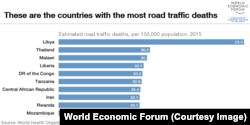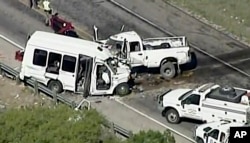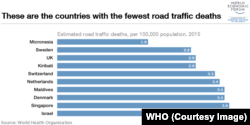From VOA Learning English, this is the Health & Lifestyle report.
Commuting is a part of life for nearly everyone.
At some point, we all need to use the roads to get to where we are going. However, in some places, commuting comes with risks. Each year, over one million people around the world die on roadways.
This number comes from the Centers for Disease Control and Prevention, or CDC, in the United States. The CDC adds that "road traffic injuries are estimated to be the eighth leading cause of death globally." And they are the "leading cause of death for young people aged 15–29."
And, it says that by 2030, road traffic injuries could become the seventh leading cause of death around the world.
Countries with the most road deaths
Most of these deaths happen in low- and middle-income countries. In 2015, the 10 countries with the most road deaths were Libya, Thailand, Malawi, Liberia, Democratic Republic of the Congo, Tanzania, Central African Republic, Iran, Rwanda and Mozambique.
The CDC reported in 2013 that among high-income countries, the United States has the highest number of road deaths. The National Safety Council, or NSC, says that 40,327 people died on U.S. roads in 2016. And in 2017 that number dropped to 40,100.
However, the NSC says that drop is not a sign of progress." The organization explains that 2016 and 2017 saw "the steepest two-year increase” in road deaths in more than 50 years.
The safety organization adds that speeding and texting while driving were two main causes for the increase.
Countries with the fewest road deaths
The countries with the fewest road deaths in 2015 were Micronesia, Sweden, United Kingdom, Kiribati, Switzerland, Netherlands, Maldives, Denmark, Singapore and Israel.
There are steps that governments and citizens can take to lower the number of road deaths.
South Korea is good example
For example, when people in South Korea wanted to cut road deaths, many different groups worked together. They attacked the problem from many directions.
The government changed and improved the country’s "transport safety acts, regulations and guidelines." They started using cameras to record where speeding and running of red lights were an issue.
Engineers in the country also improved the transportation infrastructure, the physical environments where people drive. In dangerous areas, they built new guardrails and better roads. They also built speed-control devices such as speed bumps.
Non-governmental organizations worked with governments to educate their citizens on road safety. The government updated the process of issuing driver’s licenses. Many groups created information campaigns aimed at teaching the public about the dangers of drunk driving, speeding and other high-risk behavior.
From 1992 to 2014, these efforts resulted in an almost 60 percent reduction of total road crash deaths in South Korea.
Among children, the reduction was much higher.
A report from the World Economic Forum says that during that same 22-year period, South Korea reduced road deaths among children by "almost 97 percent." In 1992, 1,566 children under the age of 14 died in road crashes. In 2014, only 53 did.
Experts at the World Economic Forum say that they knew of no other country that had experienced such a large drop in only 22 years.
Creating "School Zones"
Road safety experts say one of the most effective measures in preventing traffic deaths among children in South Korea has been the creation of “School Zones.”
A School Zone is an area within 300 meters from the main entrance of a school. These areas have stricter rules and regulations. For example, usually the speed limit is set at under 30 kilometers per hour.
The report states that drivers caught violating traffic rules in these zones receive a more severe punishment than in other areas. If caught speeding in a School Zone, for example, a driver may have their license suspended.
As of 2012, there were more than 9,000 School Zones in South Korea.
Another good example? Sweden.
Now, let’s talk about Sweden.
An article on the World Economic Forum website explains that in 1997 the government announced a plan to reduce the number of road-accident deaths to zero by 2020. Officials call it “Vision Zero.” To achieve this goal, the country made changes to the roads and created new “policies to enforce traffic laws.”
The country changed traffic patterns to make roads safer. For example, city planners increased traffic circles and reduced intersections. They added more pedestrian bridges over roads.
An article on the Economist website states that pedestrians crossing streets are protected by zebra stripes, flashing lights and speed bumps. Also, bicycles are separated from oncoming traffic.
Government officials also made the country’s drinking and driving policies much stricter. These rules have helped lower the number of people caught drinking and driving.
Since the plan began, road deaths in Sweden have been cut nearly in half. In 1996, 541 died in road crashes. In 2016, only 270 people died.
What can you do to keep yourself safer?
As governments and community groups take steps to make commuting safer, individuals can help too. Whether you are a driver or are a passenger in a vehicle, or whether you are biking or walking, there are things you can do to make your own commute safer.
On its website, the CDC lists these suggestions:
- Always use a seat belt in every seat. Even on very short trips, make sure to buckle up.
- Make sure children are always properly buckled in a car seat, booster seat, or with a usual seat belt in the back seat of the car. And make sure you are using the safest seats and buckles for the child based on age, height, and weight.
- Do not drive after drinking alcohol or taking drugs. Help others do the same. Also, do not ride with anyone who has been drinking or taking drugs.
- Obey speed limits.
- Drive without distractions. Do not use a cell phone to send text messages while driving.
- Be very careful when crossing streets. If you are traveling in another country, become familiar with its traffic laws.
- Ride only in legal taxis. Try your best to only ride in ones that have seat belts.
- Avoid riding in overcrowded, overweight, or top-heavy vehicles.
- Check the Association for Safe International Road Travel (ASIRT) website for driving hazards or risks by country.
Links to other resources and information
Organizations and governments worldwide realize the importance of road safety. So, there are events all over the world aimed at making it safer to get to where you need to be. The organization Brake lists some of these events on its website at Brake.org.
To look at road safety conditions around the world, check out an interactive map sponsored by the WHO. You can find it by going to the website or by typing “WHO Death on the Roads” into any search engine.
And that's the Health & Lifestyle report.
I'm Bryan Lynn.
And I’m Anna Matteo.
Tell us about your daily commute. Or using the traffic language in this article, tell us about the conditions of commuting where you live. You can do both in the Comments Section.
Anna Matteo wrote this story for VOA Learning English. Ashley Thompson was the editor.
______________________________________________________________
Quiz
________________________________________________________________
Words in This Story
commute – v. to travel back and forth regularly (as between a suburb and a city) : He commutes to work every day by car.
texting – v. to send a text message from one cell phone to another
regulation – n. a rule or order issued by an executive authority or regulatory agency of a government and having the force of law
infrastructure – n. the system of public works of a country, state, or region; also : the resources (such as personnel, buildings, or equipment) required for an activity
speed bump – n. a low raised ridge across a roadway (as in a parking lot) to limit vehicle speed
license – n. often used to refer specifically to a driver's license
traffic circle – n. a circular area where two or more roads meet and on which all vehicles must go in the same direction
intersection – n. the place where two or more streets meet or cross each other
pedestrian – n. of, relating to, or designed for walking : a pedestrian mall : a pedestrian bridge
buckle – n. a metal or plastic device that is attached to one end of a belt or strap and that is used to connect it to the other end; buckle up – phrasal verb to fasten your seat belt in a car or other vehicle
distraction – n. something that makes it difficult to think or pay attention
interactive – adj. designed to respond to the actions, commands, etc., of a user














